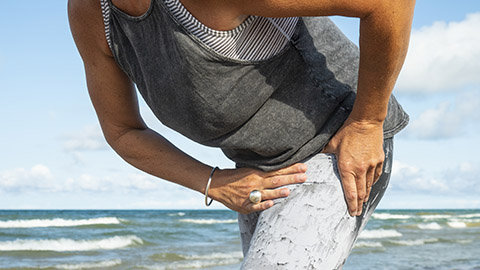11/04/2021

A mature woman has new hip and groin pain when she picks up and carries her toddler granddaughter. Her doctor diagnoses femoroacetabular impingement, and approves the idea of massage.
Femoroacetabular impingement? What is that? And is massage therapy appropriate?
Resources
Dooley, P. J. (2008) ‘Femoroacetabular impingement syndrome’, Canadian Family Physician, 54(1), pp. 42–47.
Hip Arthroscopy in Femoroacetabular Impingement (no date) Medscape. Available at: http://www.medscape.com/viewarticle/923265 (Accessed: 26 October 2021).
Hip Impingement (no date). Available at: https://www.hopkinsmedicine.org/health/conditions-and-diseases/hip-impingement (Accessed: 26 October 2021).
Nonsurgical vs Surgical Management of FAI (no date) Medscape. Available at: http://www.medscape.com/viewarticle/951224 (Accessed: 26 October 2021).
Image of femoral acetabular impingement


This podcast sponsored by:
About Anatomy Trains:
Anatomy Trains is a global leader in online anatomy education and also provides in-classroom certification programs for structural integration in the US, Canada, Australia, Europe, Japan, and China, as well as fresh-tissue cadaver dissection labs and weekend courses. The work of Anatomy Trains originated with founder Tom Myers, who mapped the human body into 13 myofascial meridians in his original book, currently in its fourth edition and translated into 12 languages. The principles of Anatomy Trains are used by osteopaths, physical therapists, bodyworkers, massage therapists, personal trainers, yoga, Pilates, Gyrotonics, and other body-minded manual therapists and movement professionals. Anatomy Trains inspires these practitioners to work with holistic anatomy in treating system-wide patterns to provide improved client outcomes in terms of structure and function.
Website: anatomytrains.com
Email: info@anatomytrains.com
Facebook: facebook.com/AnatomyTrains
Instagram: instagram.com/anatomytrainsofficial
0:00:00.0 Speaker 1: Ruth Werner's best-selling book, A Massage Therapist's Guide to Pathology is a highly regarded comprehensive resource that sets the standard for pathology education, written for massage therapy students and practitioners. This ground-breaking resource serves up a comprehensive review of the pathophysiology, signs, symptoms and treatment of more than 500 diseases and disorders. Learn more at booksofdiscovery.com.
0:00:32.2 Speaker 2: Anatomy Trains is delighted to announce a brand new dissection live stream specialty class on September 18th, LumboPelvic stability, a one-day layered dissection with Anatomy Trains' author Tom Myers and master dissector Todd Garcia. The early bird price of $150 is held until September 10th. After September 10th, the price is $250. Come see the body's actual core for yourself. This course will be provided over Zoom webinar with multiple camera views, live chat and Q&A, visit anatomytrains.com to sign up.
[music]
0:01:15.3 Ruth Werner: Hi, and welcome to, I Have a Client Who, Pathology conversations with Ruth Werner, the podcast where I will discuss your real life stories about clients with conditions that are perplexing or confusing. I'm Ruth Werner, author of A Massage Therapist's Guide to Pathology, and I have spent decades studying, writing about and teaching about where massage therapy intersects with diseases and conditions that might limit our client's health, we almost always have something good to offer, even with our most challenged clients, but we need to figure out a way to do that safely, effectively and within our scope of practice, and sometimes as we have all learned, that is harder than it looks. This week's episode is about a situation that might sound a little bit scary, and it turned out to be kind of controversial in orthopedic circles, but it's probably not a big caution for massage therapy.
0:02:15.9 RW: There's a spoiler alert. It's about this, femoroacetabular impingement. Say that three times fast. Femoroacetabular impingement, femoroacetabular impingement, femoroacetabular impingement, did it. And it comes from a massage therapist who contacted ABMP and they sent her on to me, but there are easier ways to find me, you can send me your stories at, ihaveaclientwho@abmp.com, that's ihaveaclientwho, all one word, all lowercase, at A-B-M-P dot com, or through my website at ruthwerner.com, or through my Facebook page at Ruth Werner's pathology page. I'm always looking for new stories. So keep those cards and letters coming. And now, back to our regularly scheduled programming.
0:03:06.0 RW: Our contributor today says this, "Are you familiar with femoroacetabular impingement, is massage contraindicated, if not, what is the best approach? My client's doctor is approving receiving massage." Well, I asked for a little more information, and here's what I learned, the client is a mature lady, and she has a two-year-old granddaughter who she frequently picks up and carries, the contributor says it is thought that this may have aggravated her hip and caused this situation.
0:03:40.3 RW: Okay, so we have a lady with a two-year-old granddaughter who she carries maybe on one hip as you do, I have a three-month-old granddaughter who's not quite ready for this kind of carrying, but I can't wait to do this. That's a call-out to you little Willow Rose. So this lady has recently developed some symptoms that led her to a diagnosis of femoroacetabular impingement. Well, if we take that name apart, it's not hard to visualize some possibilities, you will recall that the head of the femur snuggles up into the acetabulum, the vinegar cup, remember that? Vinegar is acetic acid. And so they named this socket that's created where the pubis ilium and ischium come together, acetabulum and the acetabulum fits around the head of the femur. How does impingement come about here?
0:04:32.0 RW: Well, it's interesting, and I looked into this and I found some information that I find a little confusing and I'm interested to see if you agree, the general consensus on femoroacetabular impingement or FAI, or just good old hip impingement as they call it over at Johns Hopkins, is that this is a situation brought about by problems with the shape of either the head of the femur or the acetabulum or both, and when these misshapen bones rub against each other, they can become irritated and grow bone spurs or become otherwise malformed and make trouble. Orthopedists and surgeons will sometimes describe this as a cam/pincer morphology, in other words, the shape of the femur, which resembles a camshaft in this analogy, and the shape of the acetabulum, which might form a problematic pincer.
0:05:26.1 RW: I found a nice picture demonstrating this on Wikimedia, and I have included it in our show notes, so when this problem exists, the way Medscape puts it, this pathologic repetitive contact with terminal ranges of hip motion can lead to labral tears, chondral damage and subsequent osteoarthritis. Well, labral tears here refers to the labrum, which comes from the Latin for lip, this is a ring of fibrocartilage that forms an extended edge or lip around the acetabulum, we also have a labrum around the glenoid fossa that helps to stabilize the head of the humerus, both of these labra, that's the plural of labrum, I looked it up, are vulnerable to tears if there's dysfunction at these ball and socket joints, and of course, chondral damage refers to injured cartilage which does not heal well, and damaged cartilage often begins the long, more or less inexorable slide into osteoarthritis, which at the hip in particular, can be severely limiting.
0:06:31.8 RW: The risk of osteoarthritis turned out to be higher with cam morphology issues that is an oddly-shaped femoral head than with the pincer morphology. And that's an interesting observation. One of the papers I read for this has a whole risk analysis with the percentage of chances of developing hip arthritis with different presentations of FAI or femoroacetabular impingement.
0:06:58.0 RW: Symptoms of FAI include pain in the groin, especially when walking or flexing the hip and decreased range of motion in the hip, and the pain and limitation gets worse over time as the structures degenerate people get stiff, they don't wanna move, and that of course makes everything worse. FAI is not always clearly demonstrable in X-rays or MRIs, sometimes it's pretty subtle, and some people may be misdiagnosed with groin strain or inguinal hernia or a low lower back injury, so some people just have the bad luck of having misshapen femoral heads or acetabula or both, and there's another congenital bone anomaly here called hip dysplasia that happens when the socket is too shallow and that joint is unstable, hip dysplasia can be tracked in really early childhood, right, because it happens so early, theoretically, so does FAI. And this is what confuses me.
0:07:55.1 RW: If FAI is also related to weirdly shaped bones, why don't we see symptoms begin in early childhood, like when kids start to walk, because usually we don't. The typical pattern is to see symptoms emerge in early to middle adulthood, especially if people are very athletic, there are a couple of other hip pain causing problems that can be confused with FAI or that can occur simultaneously, but standard imaging tests with X-rays and MRIs can generally tease these things out.
0:08:27.5 RW: One interesting line of inquiry suggests that when younger adults who would not otherwise be at risk for hip arthritis have to go through total hip replacement at a surprisingly young age, it's possible that maybe they have undiagnosed FAI, and this is significant because theoretically, FAI can be correctable before the whole hip joint is involved, if intervention can happen early enough, but that turns out to be a complicated equation, as we will see in just a moment, treatment for FAI starts with rest and modifying activities, in other words, don't use the hip in ways that cause pain, exercises and physical therapy might be recommended to help strengthen the muscles that cross the hip joint, and oral anti-inflammatories and pain medications might be suggested too. If none of that is adequate, then surgery is considered, but it is usually a last resort, depending on how extensive the damage is, arthroscopic surgery may be possible to just reshape that cam and pincer, but total hip replacement, which is a much bigger, more expensive and riskier surgery may become necessary if damage has progressed to involve the entirety of the hip joint.
0:09:45.0 RW: And there's the conundrum, hip replacement surgery is reserved for when a person's pain and limitation are intractable, but the simpler surgery with fewer risks and fewer complications that is arthroscopy, is more likely to be successful if it can be done earlier in the progression of the problem and to make things even more complicated, as we've said, FAI can be subtle and it can be missed in a radiograph or in an MRI, and that means that a person could miss out on early arthroscopic surgery that might delay or even prevent the need for a whole joint replacement, aren't you glad you're not an orthopedic surgeon who has to make this call? Okay, now that we're all tangled up, let's review. FAI is a situation where the femur or the acetabulum are not shaped in a way that they fit together correctly, it's probably a congenital condition, but the symptoms may not develop until young to middle adulthood or even later as we see in our client today, athletes probably find this condition earlier than others as they put greater demands on their hip joints than people who are not athletic, symptoms include groin pain, stiffness, limited range of motion, and these get worse over time and with continued use.
0:11:03.2 RW: Treatment includes rest, special exercises and physical therapy, symptom relieving drugs. And if necessary, arthroscopy or total hip replacement. So let's revisit our client who prompted this discussion. Again, the massage therapist asked, Are you familiar with femoroacetabular impingement, is massage contraindicated, if not, what's the best approach? My client's doctor is approving receiving massage, the client has a two-year-old granddaughter who she frequently picks up and carries, and it's thought that this may have aggravated her hip and caused this situation. Right, so right off the bat, we can safely suggest that picking up and carrying even a heavy toddler probably didn't cause this person's FAI, that had to be the result of the shape of her femur and acetabulum, possibly this newly demanding activity that she's doing with her granddaughter has elicited some new symptoms, we don't have details here on exactly what those symptoms are, but let's say it's groin pain and stiffness and limited range of motion, her doctor is "approving receiving massage," Oh boy, here we go again. Here's what I hope, I hope this doctor has realized that massage therapy can be helpful for pain relief for this patient, so they've recommended it to her and they want her to find someone who might be able to help her.
0:12:24.1 RW: This is a little different from the patient saying, "Hey, is it okay if I get massage?" and the doctor saying, "Yeah, sure. If you think it'll help." that we sometimes hear about, but I will step away from that soapbox for the moment, so when we identify key variables to figure out our risks and benefits for massage therapy and appropriate accommodations, what do we find? Among the risks she might have some hip inflammation and she might be taking drugs that interfere with pain signals, among the benefits, massage could help reduce some of the tension around that joint and that might ease some of the pressure and pain, plus massage is generally good for pain, as we know, and what accommodations might be called for? Well, first, it would be good to know if this person is getting physical therapy and what her goals are there, so we can support those efforts and not do anything to undermine them, then we wanna know if there are active anti-inflammatories or painkillers at work during our appointment.
0:13:24.1 RW: I would be sure to position this client on the table in a way to make sure her hips and low lower back are really comfortable, and speaking as someone who has received overly ambitious massage for my own occasional hip pain, I would warn this massage therapist that this area is really easily over-sensitized, just one stroke that is too deep or too sharp can require several minutes of recovery time, so maybe keep those elbows to yourself for now, and lastly, someone in acute hip pain is likely to make all kinds of postural and movement compensations that might also cause pain, limping and muscle guarding at that hip can irritate the knees and the low lower back and reverberate on from there, and massage therapy with a whole person approach can work wonders with these kinds of patterns, what's in store for this client? She might have to learn some different ways to pick up and carry her granddaughter, she might have to commit to long-term exercises to manage muscle tension at her affected hip, and if that's not enough, she might have to consider surgery so she can walk without pain.
0:14:35.8 RW: In any of these scenarios, massage therapy has a safe and effective role to play in her recovery and in her self-care.
0:14:45.6 RW: Hey everybody, thanks for listening to, I Have a Client Who, Pathology conversations with Ruth Werner. Remember, you can send me your I Have a Client Who stories to, ihaveaclientwho@abmp.com, that's, ihaveaclientwho, all one word, all lowercase, at A-B-M-P dot com. I can't wait to see what you send me and I'll see you next time.






